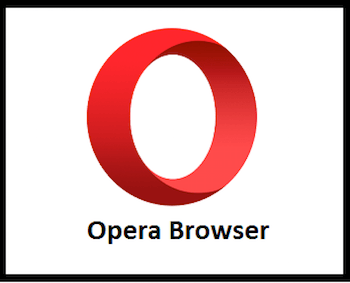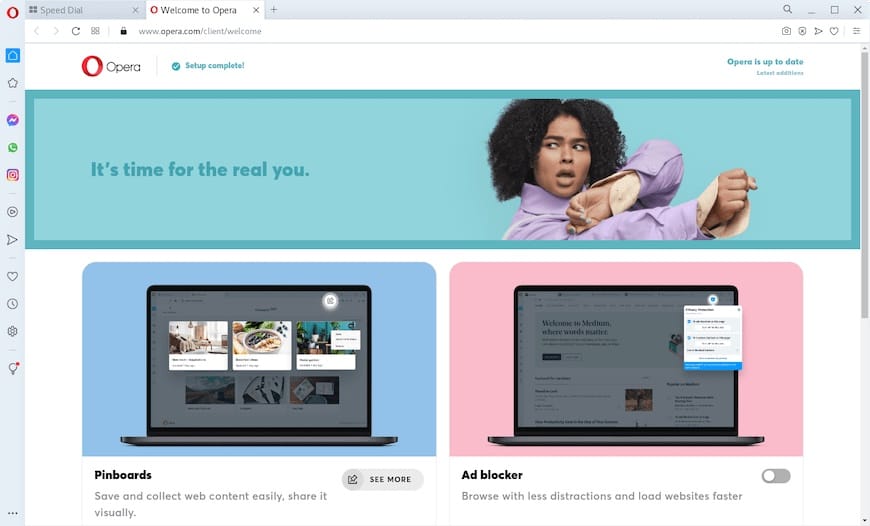How To Install Opera Browser on Debian 12

In this tutorial, we will show you how to install Opera Browser on Debian 12. Debian 12, codenamed “Bookworm,” offers a stable and reliable operating system environment. While Firefox comes as the default browser, many users prefer alternatives like Opera for its unique features and capabilities. Opera stands out with its built-in VPN, ad blocker, and innovative interface that combines functionality with sleek design. This comprehensive guide walks you through multiple methods of installing Opera Browser on Debian 12, ensuring you can enjoy this feature-rich browsing experience regardless of your technical expertise.
Opera has gained popularity among Linux users for its speed, resource efficiency, and exclusive features not found in other browsers. Whether you’re looking to enhance your browsing privacy, improve performance, or simply try something different from the default Firefox browser, Opera presents a compelling alternative that works exceptionally well on Debian systems.
Understanding Opera Browser
Opera Browser originated in Norway in 1995 and has evolved significantly over the decades. Initially developed as a research project at Norway’s largest telecommunications company, Opera has transformed into a fully-featured browser competing with industry giants. The browser pioneered many features that later became standard across other browsers, including tabbed browsing, speed dial, and integrated search.
Today’s Opera comes with numerous built-in features that set it apart from competitors. The browser includes a free VPN service that helps protect your privacy by masking your location and encrypting your connection. Its built-in ad blocker efficiently removes unwanted content without requiring additional extensions, enhancing both speed and security. Opera also offers unique tools like the sidebar integration with messaging apps and social media platforms, allowing direct access without leaving your browsing session.
For Debian 12 users, Opera requires relatively modest system specifications. Your system should have at least 1GB RAM, though 2GB or more is recommended for optimal performance. Opera can run on Debian 12 with nearly any modern CPU, making it suitable for both newer and older hardware. The browser is available in three versions: Opera Stable (the mainstream release), Opera Beta (for testing new features), and Opera Developer (for early access to experimental features).
Prerequisites for Installation
Before beginning the Opera installation process, ensure your Debian 12 system meets all requirements and is properly prepared. First, verify you have adequate disk space—at least 500MB free for the browser installation. An active internet connection is essential for downloading packages and updates.
Update your system packages to ensure compatibility and security:
sudo apt update
sudo apt upgrade -yYou’ll need administrative privileges (sudo access) to install system packages. Familiarity with basic terminal commands will help, though this guide provides all necessary commands. Consider backing up any important browser data if you’re migrating from another browser.
For repository-based installation methods, you’ll need packages that support secure HTTPS connections and key management:
sudo apt install apt-transport-https wget gnupg2 ca-certificatesThese packages ensure secure downloads and proper verification of signing keys, essential for maintaining system security when adding external repositories.
Method 1: Installing Opera via Official Repository
The most reliable method for installing Opera Browser on Debian 12 involves adding Opera’s official repository. This approach ensures you receive official updates directly from Opera Software, maintaining security and providing access to the latest features.
Step 1: Updating Your System
Begin by ensuring your package lists and installed packages are up-to-date:
sudo apt update
sudo apt upgrade -yThis step is crucial as it resolves potential dependency conflicts and security vulnerabilities before adding new software. The update command refreshes your package lists, while upgrade installs available updates for existing packages.
Step 2: Installing Required Packages
Install the necessary prerequisites:
sudo apt install apt-transport-https wget gnupg2 ca-certificatesEach package serves a specific purpose: apt-transport-https enables secure repository connections, wget downloads files from the web, gnupg2 handles encryption and signing, and ca-certificates ensures trusted certificate authorities are recognized.
Step 3: Importing Opera’s GPG Key
To verify package authenticity, import Opera’s GPG key:
wget -qO- https://deb.opera.com/archive.key | sudo apt-key add -GPG keys function as digital signatures, verifying that packages come from legitimate sources. The above command downloads Opera’s key and adds it to your system’s trusted keys. If you encounter a deprecation warning about apt-key, you can use this alternative method:
wget -qO- https://deb.opera.com/archive.key | sudo gpg --dearmor -o /usr/share/keyrings/opera-archive-keyring.gpgThis creates a keyring file in the appropriate directory for modern Debian systems.
Step 4: Adding Opera Repository
Now add Opera’s repository to your sources list:
echo "deb [signed-by=/usr/share/keyrings/opera-archive-keyring.gpg] https://deb.opera.com/opera-stable/ stable non-free" | sudo tee /etc/apt/sources.list.d/opera-stable.listThis command creates a new repository source file specifically for Opera. The “non-free” component indicates that while Opera is free to download and use, it contains proprietary code. After adding the repository, update your package index:
sudo apt updateYou may see a message about the Opera repository being added. This confirms successful repository configuration.
Step 5: Installing Opera Browser
Finally, install Opera with:
sudo apt install opera-stableDuring installation, you might be prompted about automatic reporting of statistics and crashes. For privacy-conscious users, selecting “No” is recommended. The installation process will download Opera and all required dependencies, creating desktop shortcuts and menu entries automatically.
To verify successful installation, run:
opera --versionThis should display the installed Opera version, confirming proper installation.
Method 2: Installing Opera via Snap Store
Snap packages offer an alternative installation method that works across multiple Linux distributions. This universal packaging format provides automatic updates and containerized applications.
First, install snap support on Debian 12 if not already present:
sudo apt update
sudo apt install snapd
sudo systemctl enable --now snapd.socketAfter installing snap support, it’s recommended to restart your system or at minimum log out and back in to ensure snap’s paths are updated correctly:
sudo rebootOnce snap is properly configured, install Opera with a single command:
sudo snap install operaThe snap installation automatically handles dependencies and configurations. Snap packages run in isolated environments, providing additional security but potentially with slightly slower startup times compared to native packages.
Verify your snap installation with:
snap list operaThis should display information about the installed Opera snap package. One advantage of snap installation is automatic background updates, ensuring you always have the latest version without manual intervention.
Method 3: Manual .deb Package Installation
For situations where repository access is restricted or you need a specific Opera version, manual installation using the .deb package provides an alternative approach.
First, visit the official Opera download page and obtain the latest Debian package:
wget https://download.opera.com/download/get/?partner=www&opsys=LinuxThis downloads the latest Opera .deb package. Alternatively, you can visit Opera’s download page in another browser and download the .deb file directly.
Once downloaded, install the package:
sudo dpkg -i opera-stable_*.debIf the installation stops due to missing dependencies, resolve them with:
sudo apt -f installThis command identifies and installs any missing dependencies required by Opera. After dependencies are satisfied, the installation will complete automatically.
Manual installation provides greater control over version selection but lacks automatic updates. You’ll need to repeat this process when new versions are released, making it less convenient for long-term use but ideal for testing specific versions or offline installation.
Launching and Using Opera Browser
After installation, you can launch Opera Browser in several ways. From the terminal, simply type:
operaAlternatively, find Opera in your applications menu, typically under “Internet” or “Web Browsers.” The first launch may take slightly longer as Opera completes its initial setup.
During first-time setup, Opera offers to import bookmarks and settings from other browsers. If you’re migrating from Firefox, Chrome, or another browser, this streamlines the transition by preserving your browsing history, saved passwords, and bookmarks.
To set Opera as your default browser, launch Opera and look for the prompt asking if you want to make it your default browser. Alternatively, navigate to Debian’s System Settings > Default Applications > Web Browser and select Opera from the list.
Opera’s interface provides quick access to its special features. The sidebar on the left contains shortcuts to messaging apps, Opera’s free VPN, and other tools. The Speed Dial page displays when you open a new tab, offering customizable shortcuts to your favorite websites.

Advanced Opera Features and Configuration
Opera’s built-in VPN provides basic privacy protection by routing your traffic through Opera’s servers. Enable it by clicking the VPN icon in the address bar or navigating to Settings > Advanced > Features > VPN. The free VPN lets you choose from several virtual locations and works without registration.
The integrated ad blocker efficiently removes advertisements and tracking scripts. Configure it by going to Settings > Advanced > Privacy & Security > Block ads. You can customize protection levels or whitelist specific websites.
Opera’s appearance is highly customizable through Settings > Advanced > Browser. Choose from light and dark themes, or select from Opera’s theme store for more options. The browser also supports background images for new tab pages, creating a personalized browsing environment.
For users with multiple devices, Opera Sync keeps bookmarks, passwords, and history synchronized. Enable it by clicking the profile icon in the upper right corner and selecting “Sign in to Sync.” Create an Opera account or sign in with an existing one to start synchronizing.
Opera supports extensions from both its own catalog and the Chrome Web Store, offering vast customization possibilities. Access extensions by going to Menu > Extensions > Get extensions. Unlike some browsers, Opera maintains good performance even with multiple extensions installed.
Keeping Opera Updated
When installed via the official repository, Opera updates automatically with your system’s regular updates. To manually check for updates:
sudo apt update
sudo apt upgradeFor snap installations, updates occur automatically in the background. To manually trigger a snap update:
sudo snap refresh operaIf you installed Opera using the manual .deb method, you’ll need to periodically check Opera’s website for new versions and repeat the download and installation process.
Opera typically releases updates every few weeks, with security updates receiving priority deployment. Major version updates occur several times per year, introducing new features and significant improvements.
If automatic updates fail, verify your internet connection and repository configuration. For persistent update problems, you might need to reinstall Opera using one of the methods described earlier.
Troubleshooting Common Installation Issues
Repository connection errors typically result from network issues or repository misconfiguration. If you encounter “Failed to fetch” errors, verify your internet connection and DNS settings. Try switching to a different network or using a DNS service like 1.1.1.1 or 8.8.8.8.
For GPG key verification errors, re-import the key using the commands provided earlier. If problems persist, try the alternative key import method using gpg directly.
Dependency conflicts can occur in systems with incompatible packages. The command sudo apt -f install usually resolves these issues by installing missing dependencies or suggesting package removals to maintain system integrity.
If Opera installs but fails to launch, check for error messages by starting it from terminal with the opera command. Look for output indicating missing libraries or configuration problems. Common issues include missing graphics drivers or incompatible system configurations.
For performance problems, try launching Opera with hardware acceleration disabled:
opera --disable-gpuThis bypasses GPU rendering, potentially resolving crashes related to graphics drivers.
Uninstalling Opera Browser
If you need to remove Opera, the process depends on your installation method. For repository installations:
sudo apt remove opera-stable
sudo apt autoremoveThis removes Opera and any dependencies no longer needed. To completely remove configuration files as well:
sudo apt purge opera-stableFor snap installations:
sudo snap remove operaIf you added Opera’s repository and wish to remove it:
sudo rm /etc/apt/sources.list.d/opera-stable.list
sudo apt updateTo remove user data and personal settings, delete the Opera directory in your home folder:
rm -rf ~/.config/operaThis completely removes all personalized settings, history, and cached data. Consider backing up this directory first if you might reinstall Opera later.
Congratulations! You have successfully installed Opera. Thanks for using this tutorial for installing the latest version of Opera Browser on Debian 12 “Bookworm”. For additional help or useful information, we recommend you check the official Opera website.